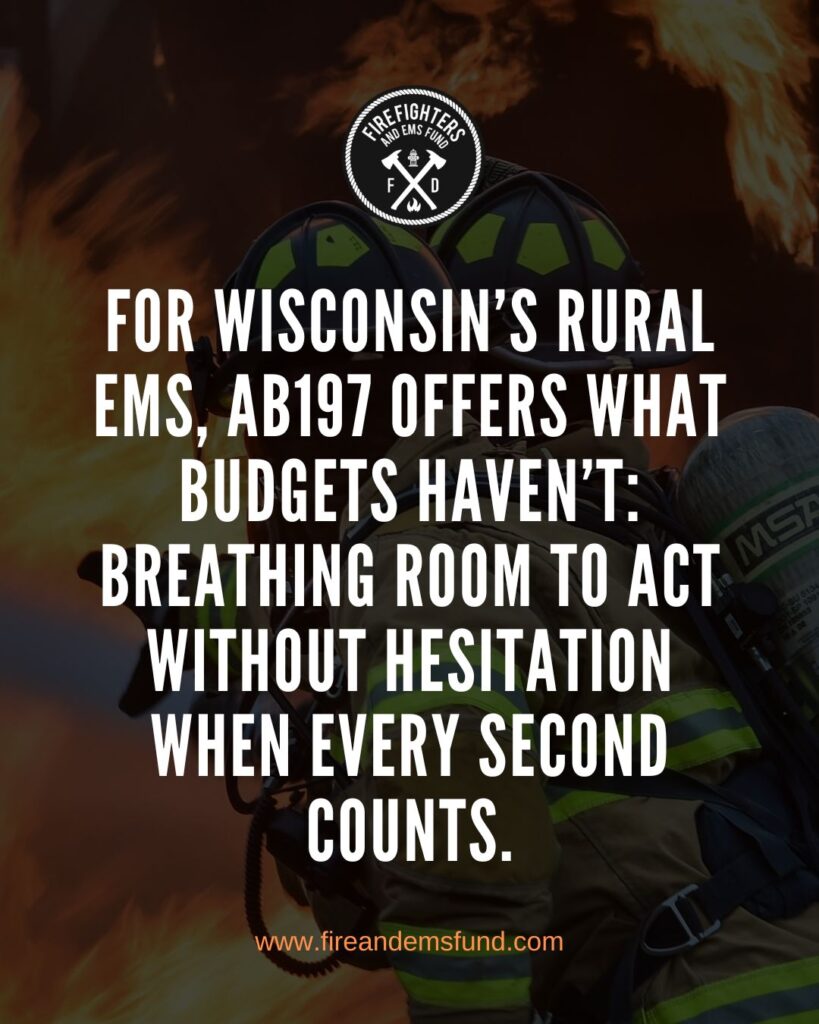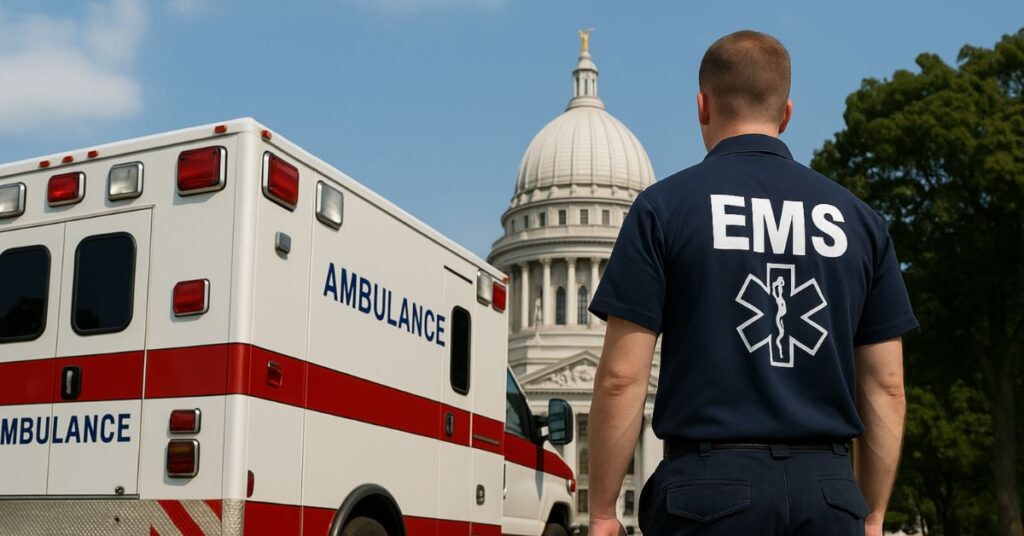Introduced on April 15, 2025, Assembly Bill 197 (or AB197) may be on the brink of providing much-needed financial relief for regional emergency medical services across the State of Wisconsin. The timing couldn’t be more crucial, as it seems set on being approved just in time for Wisconsin’s new biennial budget, which will come into effect on July 1st, 2025.
With mounting financial pressures and increasing challenges in maintaining robust emergency medical services, particularly in rural areas, AB197 offers a beacon of hope for EMS providers struggling to meet community needs while navigating complex fiscal constraints. At Firefighters and EMS Fund, we see AB197’s potential as much more than just a bureaucratic adjustment: it is a lifeline for the dedicated professionals who keep our communities safe, especially when faced with large-scale or exceptional disasters.
What Is AB197 in Wisconsin?
At its core, AB197 introduces a significant exemption to local levy limits specifically designed to support regional emergency medical services. The bill creates a unique provision that allows cities, villages, towns, and counties to levy funds for emergency medical services without being restricted by traditional budget constraints. Specifically, the legislation defines a “regional” service area as one that either covers at least 232 square miles or includes at least eight municipalities.
The bill’s key provisions include:
- A levy limit exemption for costs associated with regional emergency medical services
- Flexibility through joint emergency services districts or intergovernmental agreements
- Inclusion of fire department-provided emergency medical services under this exemption
Another key point: any expenses tied to a regional emergency will not count toward a municipality’s metrics on “expenditure restraint.” Currently, the state of Wisconsin rewards local governments that keep their expense increases below inflation levels with sizeable payments. Thanks to this provision, municipalities will not hesitate to deploy urgent aid when needed out of fear of losing these incentives.
The bill has garnered broad support, with 22 representatives and 7 senators from across Wisconsin co-sponsoring the legislation, including Representatives Kurtz, Gustafson, and Behnke, and Senators Marklein, James, and Cabral-Guevara. It received its fiscal estimate on April 30th, and appears on track for final approval.
Why AB197 Matters for Rural EMS
Rural emergency medical services have long battled with chronic underfunding and resource limitations. This is a particularly acute problem in rural jurisdictions, which serve larger areas and have access to smaller funding pools. Fundraising is further constrained by a near-statewide ban on sales taxes, leaving few options to compensate for the rising cost of services.
As a result, rural EMS departments often walk a tight financial rope to maintain adequate staffing levels, upkeep their equipment, and ensure rapid response times. Currently, municipalities are supposed to fund their EMS services through property tax levies, which cannot go above the rate of net new construction without referendum approval. But construction rates currently lag behind inflation. Therefore, according to Ari Brow from the Wisconsin Policy Forum, “in most years, most, or at least a very significant number of municipalities, counties … are not going to be able to raise property taxes by the rate of inflation.”
Even wealthy municipalities that manage “regular” day-to-day expenses well can find themselves cash-strapped when something extraordinary (such as a large wildfire, floods, a storm, or a mass casualty event) happens.
AB197 will offer a lifeline by allowing local jurisdictions to more flexibly fund their emergency medical services.

Where AB197 Fits in the State Budget Timeline
AB197 emerges at a pivotal point in Wisconsin’s complex biennial budget process. The state operates on a two-year budget cycle, which runs from July 1 of an odd-numbered year through June 30 of the next odd-numbered year. This intricate budgetary timeline involves a nearly year-long development process that began in the fall of 2024 when state agencies submitted their initial budget requests to the Department of Administration.
Significantly, Senate Bill 181 (SB181) was introduced on April 15, 2025, as the companion to AB197 in the Wisconsin Senate. This parallel legislation mirrors AB197 in both scope and purpose, aiming to exempt regional EMS costs from levy limits and modify eligibility requirements for expenditure restraint programs. The introduction of identical bills in both legislative chambers represents a strategic approach to maximize the proposal’s chances of full passage.
The alignment of AB197 and SB181 demonstrates broad, bipartisan support for EMS funding reform across Wisconsin. This dual-track approach ensures both chambers of the legislature are actively engaged in advancing this critical funding reform.
For these companion bills, the budgetary context is crucial. Both AB197 and SB181 are targeted pieces of legislation, which address EMS funding specifically. However, they need to align with the state’s broader fiscal planning. This is outlined in two other key bills.
As targeted pieces of legislation addressing EMS funding, they must navigate the broader budget discussions and align with the state’s fiscal planning (Assembly Bill 50 and Senate Bill 45), which oversee state budgets and appropriations, and the state’s executive budget, respectively.
As it approaches, the June 30 deadline creates both urgency and opportunity for local governments to secure critical funding mechanisms for emergency medical services.
Our Stand
At the Firefighters and EMS Fund, we see AB197 as a pivotal step towards sustainable EMS funding. While the bill is not a complete solution to all funding challenges, it represents a significant acknowledgment of the critical role emergency medical services play in community safety.
Therefore, we urge Wisconsin residents, EMS professionals, and local officials to stay informed about the progress of AB197 and to contact their local representatives to express support for the bill.
We also need the importance of this bill to be a part of the trending conversation and to receive adequate media attention. Together, we can make this happen by engaging in discussions about the importance of flexible EMS funding and attending any local government meetings where EMS funding will be a part of the agenda.
The survival and quality of emergency medical services depend on our collective action. AB197 is more than a bill: it’s a lifeline for communities across Wisconsin.







